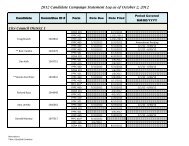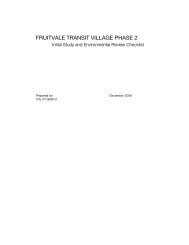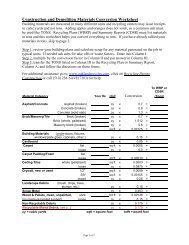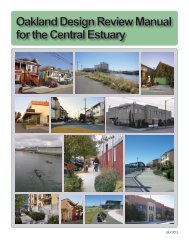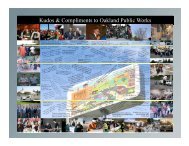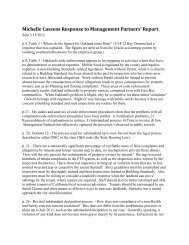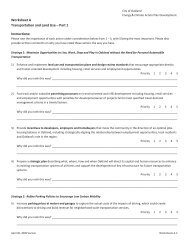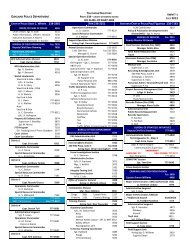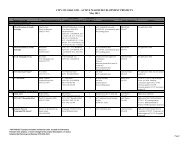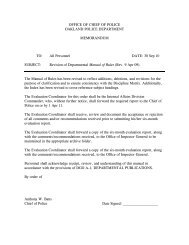Intelligent Transportation Systems - City of Oakland
Intelligent Transportation Systems - City of Oakland
Intelligent Transportation Systems - City of Oakland
Create successful ePaper yourself
Turn your PDF publications into a flip-book with our unique Google optimized e-Paper software.
TS-1 and TS-2 Options<br />
In addition to the controller types described above, the National Electrical Manufacturing<br />
Association (NEMA) has new standards for controller and cabinet options. The current<br />
standard is TS1, which is mostly proprietary and provides hardwired connection to the<br />
controller. Two new standards have been adopted by NEMA, TS-2 Type 1, and TS-2<br />
Type 2.<br />
TS1 standard has set minimum requirements for safe and effective controllers, conflict<br />
monitors, loop detectors, load switches, flashers and terminals and facilities for a NEMA<br />
based system. These requirements encompass environmental and AC power<br />
specifications, functions specifications and for the actuated controller option and<br />
connections to the controllers, through A, B, C and D connectors. TS1, however, does<br />
not have auxiliary functional specifications, such as coordination, preemption, time base<br />
control, automatic flash, diagnostics and telemetry. These functions have been<br />
implemented and available in a TS-1 standard in different ways by different<br />
manufacturers using a proprietary D connector and a telemetry connector, resulting in<br />
lack <strong>of</strong> interchangeability <strong>of</strong> the equipment between manufacturers. TS1 also does not<br />
specify the user interface, diagnostics or event logging. Currently, most <strong>of</strong> the <strong>City</strong> <strong>of</strong><br />
<strong>Oakland</strong> traffic signal controllers and cabinets are NEMA TS1 controllers.<br />
NEMA approved the TS-2 standards in 1992. TS-2 specifies controllers and cabinet by<br />
covering auxiliary functions such as coordination, preemption, time base control, and<br />
automatic flash. The TS-2 advantage is that there is no longer a proprietary item based<br />
on a manufacturer specific D connection. System level communications with devices<br />
outside <strong>of</strong> the traffic cabinet can be fully specified by the NTCIP protocols.<br />
The higher level <strong>of</strong> standardization provided by the TS-2 makes it easier for the multiplesource<br />
controllers and cabinets to upgrade from one model to another, and to<br />
interconnect cabinets from different manufacturers on the system via standardized<br />
telemetry.<br />
The TS-2 Type 1 is the pure TS-2 cabinet and controller. The standard A, B, C, D<br />
cables are replaced by a SDLC serial data bus, which provides two-way communication<br />
between all cabinet components. The serial bus interfaces it connector to the detectors<br />
and load switch via Bus Interface Units (BIUs). The TS-2 Type 1 <strong>of</strong>fers standardized<br />
interface. The bus interfaces also allows cabinet level diagnostics.<br />
The TS-2 Type 2 is a hybrid cabinet and controller, which retains some <strong>of</strong> the TS-1<br />
features. The cabinet provides both the SDLC serial interface <strong>of</strong> TS2 and the A, B, and<br />
C connectors <strong>of</strong> TS-1. As a minimum, the serial data bus is used to interconnect the<br />
controller and the conflict monitor (called Malfunction Management Unit – MMU in the<br />
TS-2 standard). The serial bus can be connected to the detector units as well. The A, B<br />
and C connectors are continued to be used to interface the controller to detectors, load<br />
switch and auxiliary equipment.<br />
The disadvantage <strong>of</strong> a TS-2 cabinet is potential maintenance costs. A typical TS-2<br />
cabinet will require an oscilloscope for diagnostics and maintenance functions. These<br />
features will result in an increase in the initial training requirement by <strong>City</strong> staff and<br />
familiarity with the TS-2 standard. However, a TS-1 cabinet can still provide similar<br />
functional capabilities as the TS-2 controller/cabinets.<br />
<strong>City</strong> <strong>of</strong> <strong>Oakland</strong> ITS Strategic Plan<br />
31 September, 2003




